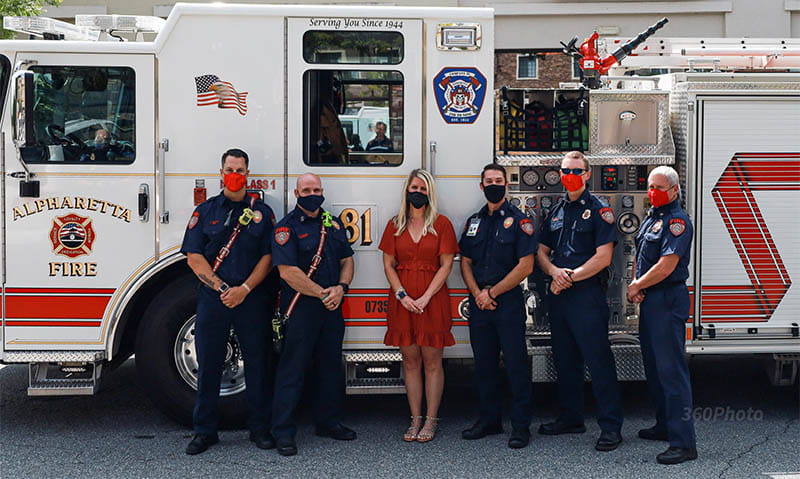








On an August morning, Nicole Tetreault, her husband, Brian, and their 2-year-old daughter, Ella, had eaten breakfast and taken a walk.
Nicole hadn’t been feeling well since Friday. She’d had a headache and was nauseous. But on Sunday she was feeling better. She’d missed several days of exercising and was eager to get back to the gym.
She joined a late morning class at her fitness club, near her home in Alpharetta, Georgia. When she arrived, she noticed a newcomer standing next to her.
During the first few minutes of warmup, before the high-intensity class began, Nicole saw herself in the mirror and thought, “I look tired. I’m not going to push myself today.”
A few minutes later, 37-year-old Nicole picked up a weight for the first set of workouts and collapsed. She shook uncontrollably, foamed at the mouth and turned purple from the chest up. She wasn’t breathing.
That newcomer standing next to her? Former cardiac nurse Jen Boyer. She immediately assessed the situation and started CPR.
The fitness instructor, Phillip Thomas, a CPR and AED instructor, ran to get the gym’s automated external defibrillator and had a co-worker call 911. Class members Kim Bickerton and Eva Mills took turns helping Boyer.
Taylor Briede at the front desk immediately called 911. Firefighters arrived within six minutes from her call. By then, the facility’s AED had been deployed twice to try restarting Nicole’s heart.
Once the paramedics took over, they delivered two more shocks and continuous CPR at the gym before finally getting a pulse and heart rate. They then transported Nicole to the hospital. In the ambulance, her heart stopped again. Again, it was restarted with a defibrillator.
Doctors placed Nicole in a medically induced coma to give her brain time to heal. She woke up three days later. A nurse came into the room shortly after.
“Good evening!” the nurse said. “How are you feeling?”
“Terrible,” Nicole replied. “Why am I here?”
“You need to call your husband,” she said. “Do you remember your password for your phone?”
“Yeah, of course,” Nicole answered, and recited the code. It was extended proof the medical team needed that she’d come through her ordeal without any brain damage.

The next day, doctors told Nicole they couldn’t find what caused her cardiac arrest. Still, to prevent her heart from stopping again, they recommended placing an implantable cardioverter defibrillator, or ICD, in her chest. The ICD would continuously monitor her heartbeat and deliver electric shocks, if needed, to restore a normal heart rhythm. She agreed.
Soon after returning home, Brian had gathered the names of everyone who had helped save Nicole. They called each of them to say thanks. They later went to the gym to deliver gift baskets and an in-person thank you.
Only then did they hear the full story of Nicole’s collapse and treatment. They also were offered to watch the gym’s security video footage from that day. They declined.
The Alpharetta Police Department later held an event at the gym to honor the staff, bystanders and firefighters who helped Nicole.
“I cried a lot that day,” Nicole said. “They saw me literally dying and if it wasn’t for them, I wouldn’t be here.”

Brian said he was especially impressed by the good Samaritans at the gym who didn’t hesitate that day, particularly considering the timing. This happened in 2020, early in the COVID-19 pandemic.
“Could I have done that? The answer before was probably no because I didn’t know how to do CPR or what an AED even was,” said Brian, who has since taken a CPR and AED class.
Nicole occasionally speaks at CPR and AED classes, giving would-be lifesavers the opportunity to hear from someone whose life was saved thanks to bystanders. She’s also become so close with Boyer, the first person to give her CPR, that Boyer calls her “my soul sister.”
“She jokes that if I wanted to be friends with her, I could have found an easier way,” Nicole said.
Three months after Nicole’s cardiac arrest and with genetic testing, doctors finally found the cause.
She has a rare genetic mutation that can cause catecholaminergic polymorphic ventricular tachycardia. CPVT causes an irregular heart rhythm that can be life-threatening. There is no cure. However, it can be managed with medicine, the ICD and twice-a-year visits to an electrophysiologist.
In January, Nicole delivered a baby boy, Brantley. Both he and Ella will receive genetic testing and yearly monitoring.
“I’m a textbook example of why everyone needs to be trained for CPR and have an AED within reach,” Nicole said. “My mission is to show people how effective they can be in a life-threatening situation.”
Stories From the Heart chronicles the inspiring journeys of heart disease and stroke survivors, caregivers and advocates.
If you have questions or comments about this American Heart Association News story, please email editor@heart.org.
American Heart Association News Stories
American Heart Association News covers heart disease, stroke and related health issues. Not all views expressed in American Heart Association News stories reflect the official position of the American Heart Association. Statements, conclusions, accuracy and reliability of studies published in American Heart Association scientific journals or presented at American Heart Association scientific meetings are solely those of the study authors and do not necessarily reflect the American Heart Association’s official guidance, policies or positions.

